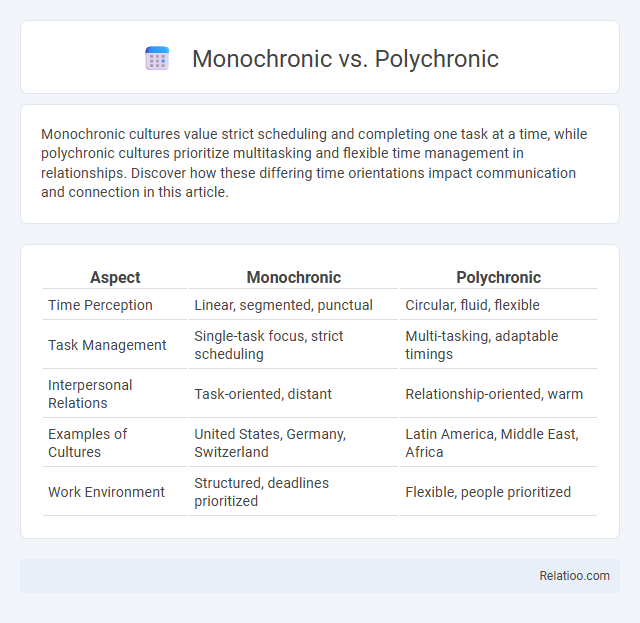Monochronic cultures value strict scheduling and completing one task at a time, while polychronic cultures prioritize multitasking and flexible time management in relationships. Discover how these differing time orientations impact communication and connection in this article.
Table of Comparison
| Aspect | Monochronic | Polychronic |
|---|---|---|
| Time Perception | Linear, segmented, punctual | Circular, fluid, flexible |
| Task Management | Single-task focus, strict scheduling | Multi-tasking, adaptable timings |
| Interpersonal Relations | Task-oriented, distant | Relationship-oriented, warm |
| Examples of Cultures | United States, Germany, Switzerland | Latin America, Middle East, Africa |
| Work Environment | Structured, deadlines prioritized | Flexible, people prioritized |
Understanding Monochronic and Polychronic Time Concepts
Monochronic time orientation emphasizes scheduling, punctuality, and completing one task at a time, aligning with cultures that value strict adherence to deadlines and linear progress. Polychronic time orientation involves multitasking, flexible scheduling, and valuing relationships over strict time constraints, often seen in cultures where human interactions and adaptability take precedence. Understanding these time concepts helps you navigate diverse work environments by adapting your approach to time management and communication based on cultural expectations.
Historical Origins of Time Perception
The historical origins of time perception reveal that monochronic cultures, rooted in Western industrialization, prioritize linear, sequential time management reflecting clock-based activities and schedules. Polychronic cultures, often found in indigenous and traditional societies, view time as cyclical and flexible, emphasizing relationships and multitasking over strict adherence to schedules. Time orientation evolved from these cultural foundations, influencing how societies organize work, social interactions, and long-term planning based on either past traditions or future goals.
Key Differences between Monochronic and Polychronic Cultures
Monochronic cultures emphasize strict schedules, punctuality, and completing one task at a time, reflecting a linear time orientation where time is segmented and managed. Polychronic cultures exhibit a more fluid approach to time, valuing multitasking, interpersonal relationships, and flexibility over rigid adherence to schedules. The key difference centers on monochronic time being task-oriented and sequential, while polychronic time prioritizes human interaction and simultaneous activities within a cyclical perception of time.
Monochronic Cultures: Characteristics and Examples
Monochronic cultures prioritize strict schedules, punctuality, and completing tasks one at a time, reflecting a linear time orientation. Time is viewed as a finite resource that must be managed efficiently, often seen in countries like the United States, Germany, and Switzerland. This cultural mindset emphasizes deadlines, planning, and adherence to predetermined schedules in both professional and personal settings.
Polychronic Cultures: Characteristics and Examples
Polychronic cultures emphasize multitasking, flexible scheduling, and prioritizing relationships over strict adherence to time, reflecting a fluid approach to daily activities. Common in regions such as Latin America, the Middle East, and parts of Africa, these cultures value human interaction and social connections, often viewing time as a cyclical concept rather than linear. Understanding your interactions within polychronic cultures helps navigate communication and expectations by appreciating how time orientation shapes priorities and behavior.
Impact on Communication Styles
Monochronic time orientation, characterized by strict schedules and punctuality, fosters direct, task-focused communication, where you expect clear agendas and timely responses. Polychronic cultures emphasize relationships and multitasking, leading to more flexible, context-rich communication that values social interactions alongside tasks. Understanding these differences in time orientation helps you adapt your communication style to improve effectiveness and build stronger cross-cultural connections.
Time Management in Different Work Environments
Monochronic time orientation emphasizes linear task completion and strict scheduling, promoting efficiency in environments requiring punctuality and deadlines, such as corporate offices. Polychronic cultures prioritize multitasking and flexible time use, which benefits collaborative and relationship-driven workplaces like creative agencies and family businesses. Understanding these contrasting time management styles enhances cross-cultural communication and optimizes productivity in multinational and diverse work environments.
Navigating Cross-Cultural Interactions
Understanding monochronic and polychronic time orientations is crucial for navigating cross-cultural interactions effectively. Monochronic cultures, such as those in the United States and Germany, prioritize punctuality, schedules, and sequential task completion, whereas polychronic cultures, common in Latin America and the Middle East, emphasize relationships, multitasking, and flexible time management. Recognizing these differences in time perception improves communication, reduces misunderstandings, and fosters stronger international business and personal relationships.
Challenges and Solutions in Multicultural Teams
Monochronic time orientation, characterized by linear task completion and strict scheduling, often clashes with polychronic cultures that prioritize relationships and multitasking, leading to misunderstandings and reduced productivity in multicultural teams. Challenges include misaligned expectations around deadlines and communication styles, causing frustration and conflict. Solutions involve cultivating cultural awareness, fostering flexible scheduling approaches, and implementing clear communication protocols to bridge time orientation differences and enhance collaboration.
Practical Tips for Adapting to Different Time Orientations
Understanding Monochronic, Polychronic, and other time orientations helps you navigate diverse cultural approaches to scheduling and deadlines. Prioritize clear communication and flexibility when working with monochronic individuals who value punctuality and task completion, whereas polychronic cultures emphasize relationships and multitasking, requiring patience and adaptability. Use practical tools like shared calendars for monochronic contexts and open, ongoing dialogues to accommodate polychronic time perspectives, enhancing collaboration and mutual respect.

Infographic: Monochronic vs Polychronic
 relatioo.com
relatioo.com